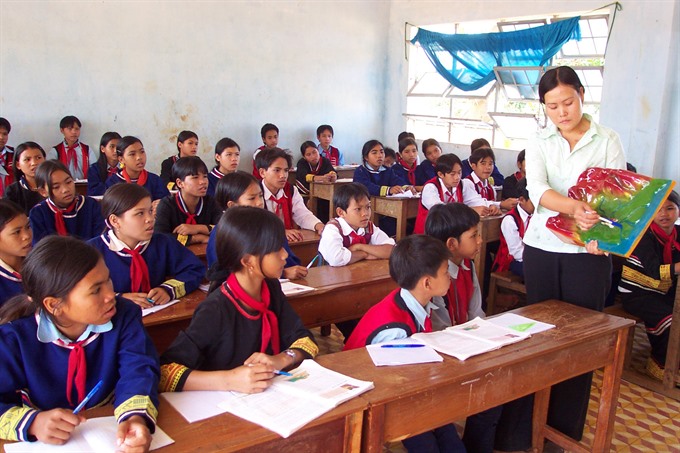 Society
Society

For students at Nguyễn Bá Ngọc Primary School in Central Highland Đắk Lắk Province’s Krông Pắc where 90 per cent of students are ethnic, Êđê language lessons are always the ones they love most.
 |
| Students of the Chư Sê Boading school for Ethnic Students in Central Highland province of Gia Lai during class. — VNA/VNS Photo Văn Thông |
GIA LAI — For students at Nguyễn Bá Ngọc Primary School in Central Highland province of Đắk Lắk’s Krông Pắc District where 90 per cent of students are ethnic, Êđê language lessons are always the ones they love most.
The lessons always take place in excited atmosphere. Students are shy and lack confidence in other subjects, but during Êđê language lessons, they become enthusiastic. Many of them volunteer to voice their opinions in their mother tongue.
“I really like these lessons. My parents do not know how to read and write in Êđê language so they encouraged me to learn,” H’Phai Kriêng, a fourth grade student, told the Đắk Lắk newspaper.
H’Nher Ayun, Krieng’s teacher, said by reading and writing in their mother tongue fluently, it was easy for them to learn other subjects, improving the overall quality of education.
It is a similar story in Kon Tum, another Central Highland province.
Most of provincial schools include ethnic language in their curricula and it received positive feedback from parents and students.
Đinh Thị Lan, deputy director of Kon Tum Province’s Department of Education and Training, said the demand to learn ethnic minority languages in the province was quite high.
More than a thousand students enrolled in the course in the 2015-16 academic year, compared with 599 in 2009-10.
“In the past, most of parents can speak Bahnar but they can’t read or write. The fact that their children can do it very well make everyone happy and proud”, said Y Lưu, a teacher at Nguyễn Thái Bình Primary School in Kon Tum City.
While teaching ethnic languages at primary schools is considered a good way to preserve ethnic traditions and their special culture characteristics, there were a lot challenges setting it up.
Due to shortage of classrooms, a number of primary schools in the province have to use nhà rông (communal house) or nhà công vụ (houses that are allotted to Government staff) as classes, according to Lan.
The biggest difficulty was a lack of professional teachers and textbooks as well as proper facilities, she said.
“Most of teachers teaching ethnic minority languages have not been trained properly in teaching skills,” Lan said.
Teacher Y Lưu said text books for ethnic languages which were previously handed out to students were very old and were wearing out.
She told the Nhân Dân (People) newspaper that schools had to use photo-copied books without coloured pages for teaching which affects students’ learning ability and little teaching equipment or visual-aids were available.
As a result, she had to set up teaching aids by herself and collect pictures to attract students’ attention.
Huỳnh Minh Thuận, from Gia Lai Province’s Department of Education and Training Department, agreed that schools were experiencing a serious lack of text books which had hindered the quality of education.
He said text books for ethnic languages haven’t been loaned to students from 2015-16 academic year and they were not available on the market. In the meantime, most of ethnic students are from disadvantaged families so schools have to use their funding to make copies of old textbooks.
There had been a constant lack of experienced and qualified teachers for ethnic minority languages at primary schools and secondary schools, Thuận told the Vietnam News Agency.
As many as 100,000 enrolled in Gia Rai course but there are only 244 teachers. To meet the demand, there should be twice as many.
And the same story goes for the Bahnar course.
Apart from lack of books and unqualified teachers, schools in the province found that it was difficult for them to arrange time for ethnic language classes, Thuận said.
In accordance with the project on strengthening the teaching of Vietnamese for kindergartens and primary schools during 2016-20 with a vision to 2025 approved by Prime Minister Nguyễn Xuân Phúc, the content and time duration for other subjects will be reduced to intensify Vietnamese language lessons for ethnic students. Thus, a number of schools had to lessen ethnic language lessons to two lessons per week or even skip them, he said.
Thuận also blamed the above-mentioned reasons for a drop in student enrolments.
Statistics from Gia Lai Province’s Department of Education and Training revealed the number of students taking part in ethnic language lessons reduced remarkably over the past three years.
In 2014-15 academic year, there were 7,117 students joining Jarai language classes and 1,101 students studying Bahnar but in 2017-18, their numbers dropped to 1,271 and 741 students, respectively.
To cope with the situation, Thuận said, priority should be given to ethnic language among optional subjects. If a student chooses English as an optional subject, he or she will have to learn two languages at the same time, he explained.
Meanwhile, Lan from Kon Tum Province’s Department of Education and Training proposed the Ministry of Education and Training revised the textbook of ethnic language to make it more relevant to local residents.
She also suggested that the ministry facilitate the opening of ethnic-language training classes for teachers where there is a shortage, allowing people to maintain their mother tongue and preserve their cultural identities. — VNS




